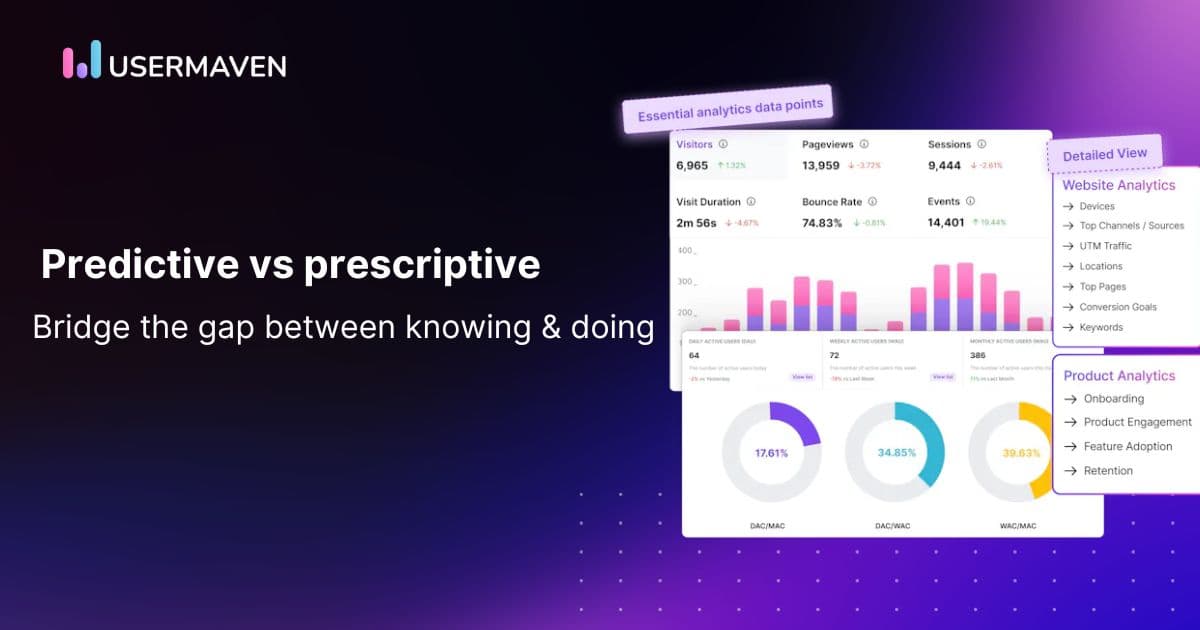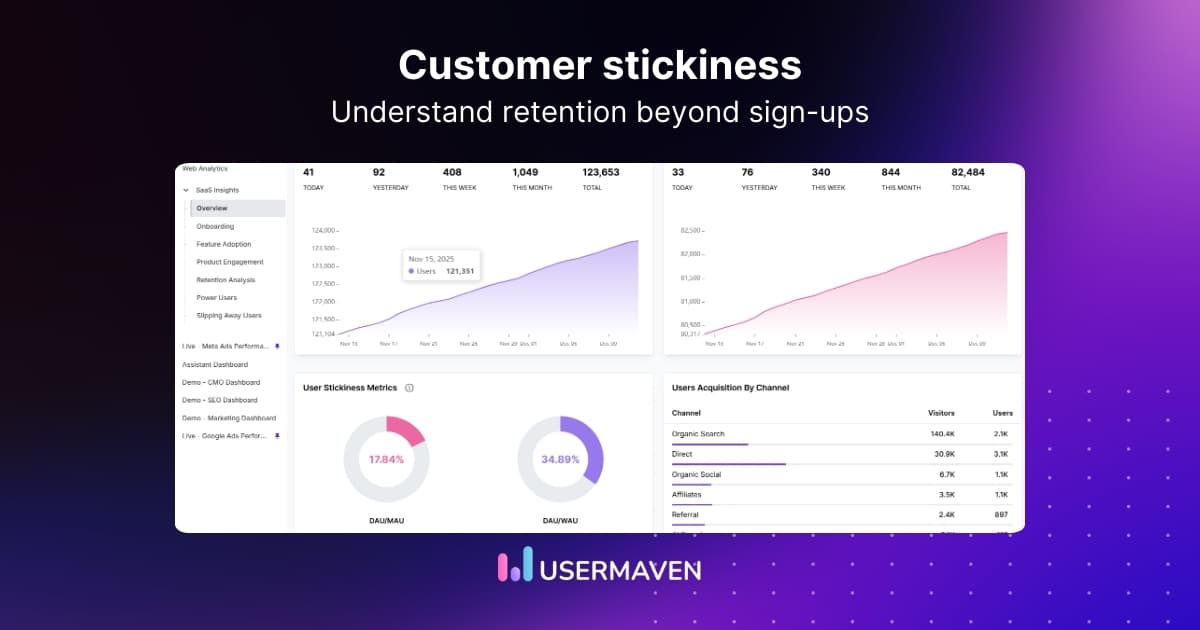Table of contents
Predictive vs prescriptive analytics and AI software development solutions
Oct 16, 2025
4 mins read
Written by Imrana Essa

You don’t want another dashboard that only tells you what went wrong yesterday. You want analytics that react in real time, spot a slipping customer before they cancel, and suggest the next sensible move for each user.
That’s where predictive analytics comes in, and if you’re serious about turning insights into action, consider working with an experienced partner in ai software development solutions.
But predictive analytics is only half the story. To go from knowing what might happen to deciding what to do next, you also need prescriptive analytics. Let’s find out how these two approaches differ, how they work together and why combining them is the key to smarter, faster decision-making.
What is predictive analytics?
Predictive analytics focuses on using past data to forecast future outcomes. It helps you see what’s likely to happen, whether it’s customer churn, conversions, or revenue growth.
It answers questions like:
- Which users are at risk of canceling?
- How likely is a free trial user to upgrade?
- What time is best to re-engage inactive users?
Example:
Imagine an ecommerce brand analyzing customer data. It finds that users who view a product more than three times but don’t add it to the cart within 24 hours are unlikely to buy. Predictive analytics can identify similar behavior patterns across users. This allows the team to automatically send a discount or reminder email before the customer disappears.
This kind of insight transforms how you work. You’re no longer reacting to lost sales or churn reports; you’re predicting and preventing them.
Usermaven simplifies this process by automatically tracking events, funnel progress, and retention patterns. Then, using machine learning models, it helps you predict which users need attention so your marketing and product teams can step in early.
How predictive analytics works
Predictive analytics follows a structured process that turns your historical data into reliable forecasts you can act on. It’s about finding patterns in what’s already happened to anticipate what’s likely to happen next.
- Collect and clean your data: Gather reliable data on user actions, purchases, signups, or support interactions.
- Define what to predict: For example, churn likelihood, trial-to-paid conversion, or product adoption.
- Train models on historical data: Machine learning algorithms identify the most important signals.
- Apply predictions to live data: The system flags users, trends, or behaviors that match high-risk or high-opportunity patterns.
- Take proactive action: Use insights to run targeted campaigns, improve onboarding flows, or refine pricing strategies.
With modern ai software development solutions, this process becomes faster and more accurate. The models continuously learn from new data, improving their predictions over time.
Drive business growth
with AI-powered analytics
*No credit card required
What is prescriptive analytics?
If predictive analytics tells you what might happen, prescriptive analytics tells you what to do about it.
It doesn’t stop at forecasting but goes a step further to recommend or even automate the best next action. Prescriptive analytics uses optimization, simulation, and AI decision models to suggest what should happen next.
Example:
Let’s say predictive analytics identifies a group of users at high risk of churn. Prescriptive analytics might then suggest:
- Sending a personalized retention email
- Offering a discount on renewal, or
- Triggering a support check-in.
Instead of simply knowing “who’s about to leave,” you know how to keep them.
Usermaven helps you act on these insights with built-in funnels, retention tracking, and attribution analysis. By connecting predictive signals with prescriptive actions, you can move from insight to intervention faster and more effectively.
How prescriptive analytics works
Prescriptive analytics takes what predictive customer analytics discovers and helps you decide the best next step. Instead of only showing what might happen, it focuses on what you should do about it.
Here’s how the process typically works:
- Use predictive insights as input: The system starts with the output from predictive analytics to identify potential risks or opportunities.
- Simulate possible outcomes: It tests different options virtually, such as “What if we send an email?” or “What if we offer a discount?” to see which scenario produces the best result.
- Optimize for impact: Using AI-driven models, it evaluates each scenario and selects the action that delivers the highest impact or efficiency.
- Execute automatically: In advanced setups, the system can take action in real time, such as displaying an in-app message, sending a notification, or routing a lead to sales.
This continuous feedback loop, where predictions inform actions and outcomes refine future predictions, is what gives AI-powered analytics its strength.
Key differences between predictive and prescriptive analytics
Predictive analytics helps you anticipate what might happen, while prescriptive analytics focuses on choosing the best response to those predictions. Here’s a conclusive comparison;
| Aspect | Predictive analytics | Prescriptive analytics |
| Goal | Forecast what’s likely to happen | Recommend what action to take |
| Focus | Understanding patterns | Optimizing decisions |
| Techniques | Regression, machine learning, data mining | Optimization, simulation, reinforcement learning |
| Output | Probabilities, forecasts, alerts | Actionable recommendations or automation |
| Example | Predicting churn risk | Recommending a retention offer |
How AI software development solutions bridge the gap
The real power of ai-driven software solutions lies in how they connect predictive and prescriptive analytics into a single, intelligent system.
Here’s how they do it:
- Continuous learning: AI models refine their accuracy as they process new data.
- Real-time decisioning: Systems can trigger actions instantly, like showing a personalized message or adjusting a campaign.
- Automation at scale: Actions happen automatically, freeing your team to focus on strategy, not manual work.
- Cross-platform integration: AI connects product data, marketing touchpoints, and sales systems for end-to-end visibility.
For example, a SaaS company predicts that certain users are likely to downgrade based on low product activity. An ai-powered prescriptive engine then suggests offering those users a feature tutorial or a limited-time upgrade incentive. The result? Fewer downgrades and higher engagement, all automated.
Why this matters for SaaS and product teams
For SaaS and ecommerce brands, predictive and prescriptive analytics aren’t just buzzwords; they’re growth levers.
Here’s how they drive results when powered by Usermaven and ai technologies:
- Increase retention: Predict churn, then act fast with personalized engagement.
- Improve onboarding: Identify users stuck in the funnel and prescribe tailored walkthroughs.
- Boost conversions: Predict high-intent users and recommend next steps to move them toward purchase.
- Optimize marketing spend: Use predictive insights to target only the most promising leads, and prescriptive analytics to refine ad strategy.
- Drive product-led growth: See how users behave in-app and automatically surface relevant actions to push them toward activation.
When combined with ai-driven analytics platforms, these strategies become scalable and continuous. This ensures your team always has the right data, predictions, and next steps at hand.
How to get started
You don’t need an in-house ai team to start using predictive and prescriptive analytics. The first step is to capture and organize the right data and that’s where Usermaven helps.
Capture the right data
Use Usermaven to track key events, funnels, and user segments. This ensures you have reliable data to feed into future predictive or ai-based tools.
Analyze user behavior
Identify where users drop off, which features drive engagement, and what actions lead to conversion or churn.
Build simple predictive insights
Start by recognizing early warning signs manually, for example, users who stop engaging or abandon onboarding flows.
Experiment with prescriptive actions
Based on these insights, test and track campaigns, in-app prompts, or targeted offers to improve outcomes.
Refine continuously
Track how your interventions perform and keep adjusting your strategy as you collect more data.
With Usermaven’s advanced features, you already have the structured data foundation you need. Over time, you can layer predictive models or ai-powered systems on top, turning insight into action with confidence.
Final thoughts
Predictive analytics helps you understand what’s likely to happen next. Prescriptive analytics goes a step further by showing you the best way to respond. Together, they shift analytics from simply reporting the past to actively shaping the future.
AI software development solutions make this possible by turning raw data into meaningful insights and actionable recommendations. But to get there, you first need a strong data foundation.
That’s exactly what Usermaven delivers. It gives you the visibility and behavioral insights needed to understand user intent, identify growth opportunities, and take the right action at the right time.
If you’re ready to move from analysis to action, Usermaven is the website analytics tool built to get you there. Book a demo today and see how effortlessly you can turn data into growth.
Unlock insights that drive growth
*No credit card required
FAQs
What kind of data do I need for predictive and prescriptive analytics?
You’ll need historical and behavioral data, such as event tracking, user journeys, purchase history, and engagement metrics. Tools like Usermaven help collect and organize this data automatically, ensuring a strong foundation for deeper analytics later on.
Do I need advanced technical skills to start using predictive or prescriptive analytics?
Not necessarily. Many teams begin by identifying behavioral trends and simple patterns without machine learning. As your analytics maturity grows, you can layer on more advanced predictive or prescriptive models. The key is starting with a solid understanding of your data and user behavior.
Can predictive and prescriptive analytics improve customer retention?
Absolutely. Predictive analytics helps you identify users at risk of leaving, and prescriptive analytics helps you determine the best way to re-engage them. Together, they help businesses retain more users by responding to issues before they lead to churn.
How can predictive and prescriptive analytics help product teams, not just marketing?
For product teams, predictive analytics can forecast which features users are likely to adopt or ignore, while prescriptive analytics can recommend in-app guidance to improve engagement. Together, they help prioritize product improvements and personalize the user experience using the captured event data.
Try for free
Grow your business faster with:
- AI-powered analytics & attribution
- No-code event tracking
- Privacy-friendly setup


